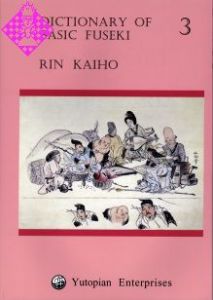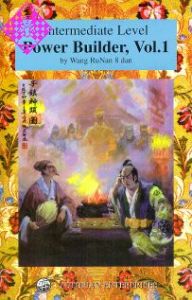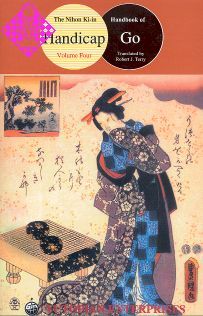Artikelnummer
LGKIIHG04
Autor
Handbook of Go
Y33 - Handicap, Vol. 4
236 Seiten, kartoniert, Yutopian, 2000
Final vergriffen
GO - The pursuit of Life, Liberty, Connection, Influence and Territory. Each player seeks to discover the strategy and tactics necessary to acquire the most territory. Ideally each play should have multiple aims to threaten or succeed to create, destroy, expand, and/or reduce Life, Liberty, Connection, Influence, and/or Territory. THE ART OF GO - To find a maneuver that equally divides a section of the board taking into account the player's overall strategy and tactics. OBJECTIVE - To help Go players: 1) Learn the basic language and elements of Go; 2) Understand what is happening on the Go board; 3) Develop their Go analytical reading ability.
The reader may be familiar with books that claim to reveal "Sure-Fire Winning Strategies For Handicap Go." But what really matters is one's personal strength. The goal here is to provide an effective method to boost one's efforts and quickly enhance real strength in one's game. We have strived to distill the essence of nine through three stone handicap games and selected the patterns that are most likely to arise. Instruction is geared to the significance of the placement of the handicap stones and the correct way to assess the opening of the game. Therefore, the motto followed here is the iron-clad rule for black in handicap go: "Strike in the opening." The policy is an unwavering adherence to thick and strong tactics, discarding the negative strategy of always defending with the knight's jump in the corner.
But while encouraging aggressive tactics when conditions merit them and presenting examples to back them up, this is not everything. The point is that there are many options available, including a diagonal attachment, a one point jump and a pincer, depending upon the handicap stones at one's disposal.
The whole board diagrams presented are refined examples from instructional games, with positions elaborated upon to the end result. The purpose has been to explain the key to each pattern so that the reader might use them to fight effectively. As far as possible, the intent has been to make this the bible of handicap go.
The reader may be familiar with books that claim to reveal "Sure-Fire Winning Strategies For Handicap Go." But what really matters is one's personal strength. The goal here is to provide an effective method to boost one's efforts and quickly enhance real strength in one's game. We have strived to distill the essence of nine through three stone handicap games and selected the patterns that are most likely to arise. Instruction is geared to the significance of the placement of the handicap stones and the correct way to assess the opening of the game. Therefore, the motto followed here is the iron-clad rule for black in handicap go: "Strike in the opening." The policy is an unwavering adherence to thick and strong tactics, discarding the negative strategy of always defending with the knight's jump in the corner.
But while encouraging aggressive tactics when conditions merit them and presenting examples to back them up, this is not everything. The point is that there are many options available, including a diagonal attachment, a one point jump and a pincer, depending upon the handicap stones at one's disposal.
The whole board diagrams presented are refined examples from instructional games, with positions elaborated upon to the end result. The purpose has been to explain the key to each pattern so that the reader might use them to fight effectively. As far as possible, the intent has been to make this the bible of handicap go.
GO - The pursuit of Life, Liberty, Connection, Influence and Territory. Each player seeks to discover the strategy and tactics necessary to acquire the most territory. Ideally each play should have multiple aims to threaten or succeed to create, destroy, expand, and/or reduce Life, Liberty, Connection, Influence, and/or Territory. THE ART OF GO - To find a maneuver that equally divides a section of the board taking into account the player's overall strategy and tactics. OBJECTIVE - To help Go players: 1) Learn the basic language and elements of Go; 2) Understand what is happening on the Go board; 3) Develop their Go analytical reading ability.
The reader may be familiar with books that claim to reveal "Sure-Fire Winning Strategies For Handicap Go." But what really matters is one's personal strength. The goal here is to provide an effective method to boost one's efforts and quickly enhance real strength in one's game. We have strived to distill the essence of nine through three stone handicap games and selected the patterns that are most likely to arise. Instruction is geared to the significance of the placement of the handicap stones and the correct way to assess the opening of the game. Therefore, the motto followed here is the iron-clad rule for black in handicap go: "Strike in the opening." The policy is an unwavering adherence to thick and strong tactics, discarding the negative strategy of always defending with the knight's jump in the corner.
But while encouraging aggressive tactics when conditions merit them and presenting examples to back them up, this is not everything. The point is that there are many options available, including a diagonal attachment, a one point jump and a pincer, depending upon the handicap stones at one's disposal.
The whole board diagrams presented are refined examples from instructional games, with positions elaborated upon to the end result. The purpose has been to explain the key to each pattern so that the reader might use them to fight effectively. As far as possible, the intent has been to make this the bible of handicap go.
The reader may be familiar with books that claim to reveal "Sure-Fire Winning Strategies For Handicap Go." But what really matters is one's personal strength. The goal here is to provide an effective method to boost one's efforts and quickly enhance real strength in one's game. We have strived to distill the essence of nine through three stone handicap games and selected the patterns that are most likely to arise. Instruction is geared to the significance of the placement of the handicap stones and the correct way to assess the opening of the game. Therefore, the motto followed here is the iron-clad rule for black in handicap go: "Strike in the opening." The policy is an unwavering adherence to thick and strong tactics, discarding the negative strategy of always defending with the knight's jump in the corner.
But while encouraging aggressive tactics when conditions merit them and presenting examples to back them up, this is not everything. The point is that there are many options available, including a diagonal attachment, a one point jump and a pincer, depending upon the handicap stones at one's disposal.
The whole board diagrams presented are refined examples from instructional games, with positions elaborated upon to the end result. The purpose has been to explain the key to each pattern so that the reader might use them to fight effectively. As far as possible, the intent has been to make this the bible of handicap go.
| EAN | 9781889554280 |
|---|---|
| Gewicht | 320 g |
| Hersteller | Yutopian |
| Breite | 13,9 cm |
| Höhe | 21,5 cm |
| Medium | Buch |
| Erscheinungsjahr | 2000 |
| Autor | Nihon Ki-in |
| Sprache | Englisch |
| ISBN-10 | 1889554286 |
| ISBN-13 | 9781889554280 |
| Seiten | 236 |
| Einband | kartoniert |
| Name | Yutopian Enterprises |
|---|---|
| yutopian@netcom.com |
i Foreword
iv Notes on the Organization of this Book
001 Chapter 1: Nine Stone Games
002 Insight Regarding Nine Stone Games
003 Pattern 1 The Diagonal Attachment (1)
007 Pattern 2 The Diagonal Attachment (2)
012 Pattern 3 The Diagonal Attachment (3)
016 Pattern 4 The One-Point jump (1)
022 Pattern 5 The One-Point jump (2)
026 Pattern 6 The One-Point jump (3)
029 Pattern 7 The One-Point jump (4)
033 Pattern 8 The One-Point jump (5)
037 Pattern 9 The One-Point jump (6)
041 Chapter 2: Eight Stone Games
02 Guidelines For Eight Stone Games
043 Pattern 1 White's Play on the Center Point
047 Pattern 2 Attaching and Extending
053 Pattern 3 The One-Point Jump
057 Chapter 3: Seven Stone Games
058 Guidelines For Seven Stone Games
059 Pattern 1 The Wide High Pincer (1)
063 Pattern 2 The Wide High Pincer (2)
069 Pattern 3 The Wide High Pincer (3)
073 Pattern 4 The Narrow High Pincer (1)
077 Pattern 5 The Narrow High Pincer (2)
081 Pattern 6 The Narrow Low Pincer
087 Pattern 7 The One-Point Jump (1)
091 Pattern 8 The One-Point Jump (2)
095 Chapter 4: Six Stone Games
096 Guidelines For Six Stone Games
097 Pattern 1 The Wide Low Pincer (1)
101 Pattern 2 The Wide Low Pincer (2)
105 Pattern 3 The Wide Low Pincer (3)
109 Pattern 4 The One-Point Jump (1)
113 Pattern 5 The One-Point Jump (2)
118 Pattern 6 The One-Point Jump (3)
121 Chapter 5: Five Stone Games
122 Guidelines For Five Stone Games
123 Pattern 1 The One-Point Jump (1)
129 Pattern 2 The One-Point Jump (2)
134 Pattern 3 The One-Point Jump (3)
139 Pattern 4 The One-Point Jump (4)
147 Pattern 5 The Wide Low Pincer (1)
154 Pattern 6 The Wide Low Pincer (2)
160 Pattern 7 The Wide Low Pincer (3)
165 Chapter 6: Four Stone Games
166 Guidelines For Four Stone Games
167 Pattern 1 The One-Point Jump (1)
173 Pattern 2 The One-Point Jump (2)
180 Pattern 3 The One-Point Jump (3)
184 Pattern 4 The One-Point Jump (4)
188 Pattern 5 The One-Point Jump (5)
193 Pattern 6 The Wide Low Pincer
199 Chapter 7: Three Stone Games
200 Guidelines For Three Stone Games
201 Pattern 1 Approaching the Corner (13 Models)
230 Pattern 2 Not Approaching the Corner (3 Models)
233 Glossary
iv Notes on the Organization of this Book
001 Chapter 1: Nine Stone Games
002 Insight Regarding Nine Stone Games
003 Pattern 1 The Diagonal Attachment (1)
007 Pattern 2 The Diagonal Attachment (2)
012 Pattern 3 The Diagonal Attachment (3)
016 Pattern 4 The One-Point jump (1)
022 Pattern 5 The One-Point jump (2)
026 Pattern 6 The One-Point jump (3)
029 Pattern 7 The One-Point jump (4)
033 Pattern 8 The One-Point jump (5)
037 Pattern 9 The One-Point jump (6)
041 Chapter 2: Eight Stone Games
02 Guidelines For Eight Stone Games
043 Pattern 1 White's Play on the Center Point
047 Pattern 2 Attaching and Extending
053 Pattern 3 The One-Point Jump
057 Chapter 3: Seven Stone Games
058 Guidelines For Seven Stone Games
059 Pattern 1 The Wide High Pincer (1)
063 Pattern 2 The Wide High Pincer (2)
069 Pattern 3 The Wide High Pincer (3)
073 Pattern 4 The Narrow High Pincer (1)
077 Pattern 5 The Narrow High Pincer (2)
081 Pattern 6 The Narrow Low Pincer
087 Pattern 7 The One-Point Jump (1)
091 Pattern 8 The One-Point Jump (2)
095 Chapter 4: Six Stone Games
096 Guidelines For Six Stone Games
097 Pattern 1 The Wide Low Pincer (1)
101 Pattern 2 The Wide Low Pincer (2)
105 Pattern 3 The Wide Low Pincer (3)
109 Pattern 4 The One-Point Jump (1)
113 Pattern 5 The One-Point Jump (2)
118 Pattern 6 The One-Point Jump (3)
121 Chapter 5: Five Stone Games
122 Guidelines For Five Stone Games
123 Pattern 1 The One-Point Jump (1)
129 Pattern 2 The One-Point Jump (2)
134 Pattern 3 The One-Point Jump (3)
139 Pattern 4 The One-Point Jump (4)
147 Pattern 5 The Wide Low Pincer (1)
154 Pattern 6 The Wide Low Pincer (2)
160 Pattern 7 The Wide Low Pincer (3)
165 Chapter 6: Four Stone Games
166 Guidelines For Four Stone Games
167 Pattern 1 The One-Point Jump (1)
173 Pattern 2 The One-Point Jump (2)
180 Pattern 3 The One-Point Jump (3)
184 Pattern 4 The One-Point Jump (4)
188 Pattern 5 The One-Point Jump (5)
193 Pattern 6 The Wide Low Pincer
199 Chapter 7: Three Stone Games
200 Guidelines For Three Stone Games
201 Pattern 1 Approaching the Corner (13 Models)
230 Pattern 2 Not Approaching the Corner (3 Models)
233 Glossary
The reader may be familiar with books that seductively claim to reveal "Sure-Fire Winning Strategies For Handicap Go." But what really matters is one's personal strength, and there is no beating around the bush about it.
To that end, one wonders if there is a method to effectively boost one's efforts, or a process to quickly enhance real strength in one's game. That is the goal here. We have strived to distill the essence of nine through, three stone handicap games, and depending on the number of handicap stones, selected the patterns that are most likely to arise. Instruction is geared to the significance of the placement of the handicap stones and the correct way to assess the opening of the game. Therefore, the motto followed here is the iron-clad rule for black in handicap go: "Strike in the opening." The offensive policy is an unwavering adherence to thick and strong tactics, discarding the negative strategy of always defending "only" with a knight jump in the corner.
But while encouraging aggressive tactics when conditions merit them, and presenting examples to back them up, this is not everything. There are many options available and the patterns presented here focus on a diagonal attachment, a one-point jump, and a pincer, depending upon the handicap stones at one's disposal.
The whole board diagrams presented here are refined examples from actual instructional games and include a detailed analysis of various positions. The purpose is to explain the key strategy and maneuvers in each pattern so that the reader can use them to strengthen their fighting abilities. As far as possible, the intent has been to make this the bible of handicap go.
The present work is based upon the 1983 publication of the Nihon Kiin's "Quick Study Series: Handicap Go Pocket Dictionary" and has been revised and expanded.
Foreword
To that end, one wonders if there is a method to effectively boost one's efforts, or a process to quickly enhance real strength in one's game. That is the goal here. We have strived to distill the essence of nine through, three stone handicap games, and depending on the number of handicap stones, selected the patterns that are most likely to arise. Instruction is geared to the significance of the placement of the handicap stones and the correct way to assess the opening of the game. Therefore, the motto followed here is the iron-clad rule for black in handicap go: "Strike in the opening." The offensive policy is an unwavering adherence to thick and strong tactics, discarding the negative strategy of always defending "only" with a knight jump in the corner.
But while encouraging aggressive tactics when conditions merit them, and presenting examples to back them up, this is not everything. There are many options available and the patterns presented here focus on a diagonal attachment, a one-point jump, and a pincer, depending upon the handicap stones at one's disposal.
The whole board diagrams presented here are refined examples from actual instructional games and include a detailed analysis of various positions. The purpose is to explain the key strategy and maneuvers in each pattern so that the reader can use them to strengthen their fighting abilities. As far as possible, the intent has been to make this the bible of handicap go.
The present work is based upon the 1983 publication of the Nihon Kiin's "Quick Study Series: Handicap Go Pocket Dictionary" and has been revised and expanded.
Foreword
Mehr von Yutopian
-
 WeiQi In Culture 112,50 €
WeiQi In Culture 112,50 € -
 21st Century New Openings15,50 €
21st Century New Openings15,50 € -
 Dictionary of Basic Fuseki 318,50 €
Dictionary of Basic Fuseki 318,50 € -
 Dictionary of Basic Fuseki 418,50 €
Dictionary of Basic Fuseki 418,50 € -
 Power Builder, Vol. 117,00 €
Power Builder, Vol. 117,00 € -
 Tesuji Made Easy For Windows59,95 €
Tesuji Made Easy For Windows59,95 €

